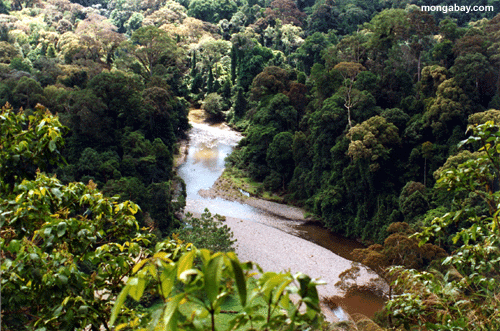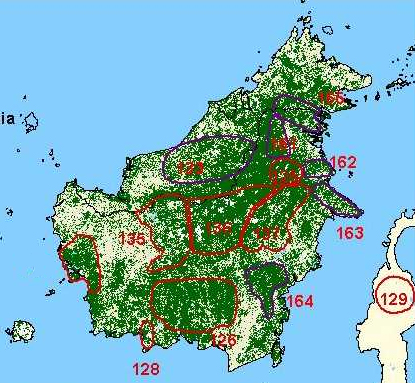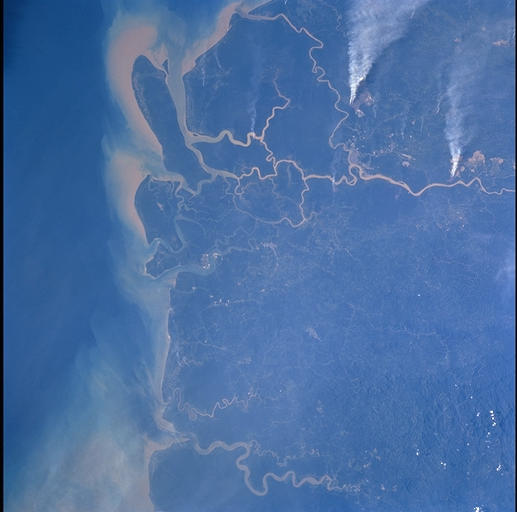Deforestation in Borneo
Kalimantan at the Crossroads: Dipterocarp Forests and the Future of Indonesian Borneo
Tina Butler, mongabay.com
April 13, 2005
EDITOR’S NOTE: Borneo, the third largest island in the world, was once covered with dense rainforests. With swampy coastal areas fringed with mangrove forests and a mountainous interior, much of the terrain was virtually impassable and unexplored. Headhunters ruled the remote parts of the island until a century ago.
In the 1980s and 1990s Borneo underwent a remarkable transition. Its forests were leveled at a rate unparalleled in human history. Borneo’s rainforests went to industrialized countries like Japan and the United States in the form of garden furniture, paper pulp and chopsticks. Initially most of the timber was taken from the Malaysian part of the island in the northern states of Sabah and Sarawak. Later forests in the southern part of Borneo, an area belonging to Indonesia and known as Kalimantan, became the primary source for tropical timber. Today the forests of Borneo are but a shadow of those of legend.
The southern half of Borneo contains some of the richest and most unique ecosystems on the planet. Indonesian Borneo, known as Kalimantan, is also one of the most environmentally threatened places on Earth. While many scientists have come to study this region, opportunities for observation are becoming increasingly scarce with the current perils facing the forests of Kalimantan.
 Rainforest in Borneo |
Dr. Lisa Curran has spent a good portion of her professional career studying ecosystems in this area. From 1984 to 2001, she led a comprehensive study documenting the rate of forest loss in Western Kalimantan and surveyed an area of over four million hectares (about 9.9 million acres). The results of her work were published last February and her findings are numbing.
The report estimates that “protected” lowland forests have decreased by more than 56 percent, meaning some six and a half million acres are gone forever. Parks supposedly off limits to loggers have fallen as laws are ignored by timber barons with political connections, while large areas of forest in Kalimantan have been cleared for palm oil plantations that, in many cases, have yet to be planted.
Biologically rich Dipoterocarp forests
One of the primary areas of study for Dr. Curran beyond a general survey of the region, has been the particular observation of tree reproduction within the Dipterocarpaceae family, the main family of canopy trees in Kalimantan rainforests. The rare Dipterocarp trees, of which there are about 385 species from nine genres, are regarded as unique ecosystems, with an intricately attuned connection to the environment.
Tree production in this family is inextricably linked to the arrival of El Niño. Dipterocarps synchronize their reproduction, called masting, to the onset of the El Niño Southern Oscillation, which occurs approximately once every four years. The traditional climatic conditions of an El Niño year stimulate synchronous fruiting and subsequent flowering in the Dipterocarps and are imperative for regional seed production, and ultimately, forest regeneration. Individual trees may carry up to 120 fruits and the trees have been known to synchronize over a scale of 370 million acres.
During a “Dipterocarp year” in Kalimantan, the canopy bursts into color as countless emergent Dipterocarp trees flower almost simultaneously. These mast flowerings, while correlated to El Niño, still occur somewhat randomly. This may be a strategy to intermittently starve and swamp seed predators so that at least some seeds survive to germination. The principle pollinators of Dipterocarps are small insects called thirps, which have adapted short life cycles to coincide with the irregular masting periods. Between instances of flowering, small thirp populations feed on understory flowers for subsistence and when a mass flowering is triggered, the pollinating populations increase exponentially to take advantage of the vast number of blooms–around four million per tree.
Typically, natural seed production is so immense that there is a surplus for local fauna to gorge upon and local people to collect and sell. Dr. Curran’s observations noted significant changes in animal migration patterns and increases in populations during masting periods as animals come to feed. The trees produce so many seeds that the forest floor is literally carpeted during a five week period when a staggering 96 percent of the seeds may fall to the ground. With such a dense layering of seed it would seem there would be more than enough opportunity for some seedlings to ascend to the canopy. However, with the present state of affairs in Kalimantan, this apparent excess of seeds is proving to be not nearly sufficient.
 TREES ‘Deforestation Hot Spots’, overlaid on a digital forest cover classification based on 1 km NOAA AVHRR data. Achard, F., Eva, H.D., Glinni, A., Mayaux, P., Stibig, H-J., Richards, T., 1998, Identification Of Deforestation Hot Spot Areas In The Humid Tropics, TREES Publications Series B, Research Report No.4, European Commission, Luxembourg |
What has changed in the Dipterocarp forests as a result of indiscriminate and heavy logging is the quantity of life-bearing seeds. Intensive logging in Kalimantan near the Gunung Palung National Park over the past two decades has taken a major toll on this reproductive cycle. In 1991, seed production was around 175 pounds per acre. By 1998, this number had plummeted to 16.5 pounds per acre, even though it was a major El Niño year. According to research gleaned by scientists, logging appears to reduce local density and biomass of mature trees and also limits the spatial extent of masting and inhibits the forest’s normal response by disrupting soil conditions. Extended drought stress is another effect of the felling. The reduction of seed results in a loss for the forest, the animals and the people.
The disappearance of the Dipterocarp forests of Borneo would be more than a simple environmental loss; it would cause significant damage to Kalimantan economy which relies heavily on the timber industry that produces approximately $9.2 billion annually. Western Kalimantan is the third largest exporting region in Indonesia which controls 95 percent of the world’s tropical plywood trade and provides 80 percent of the plywood used in the United States. Currently more tropical timber is extracted from Borneo than all of Latin America and Africa combined. The success of the timber industry In Kalimantan is threatening its own survival by destroying this delicately functioning and interconnected ecosystem.
 Rainforest destruction |
Paper parks
The problem with attempting to regulate or limit the rate of destruction is tied to the flaws in the administration and function of Kalimantan’s parks. The three established national parks in Indonesia–Gunung Palung, Bukit Baka/Bukit Raya and Bentuang Karimun are not protected in the traditional sense. “Protected” here means that lands encompassed within the parks are to be used by local communities for the harvesting of all forest products, including timber and wildlife. 79 percent of the forested area is operated by state-run timber concessions handed out to military interests and only six percent of this region is nominally protected in the sense described previously.
Since former dictator Suharto’s downfall in 1998, a policy of decentralization has been implemented throughout the Indonesia resulting in changes in the administration of national parks. Today local park officials are often poorly paid, so they use their positions to demand cash payments from enterprising locals, including illegal logging groups. As a result, the park system is plagued with corruption, a booming bribery-based economy and increasingly compromised forests. According to the World Bank, about 70 percent of the timber in the region is felled illegally.
Dipterocarps suffer
Seeds from Dipterocarp trees generate about $25.8 million annually for local residents, but seed harvesting is in direct competition with commercial logging — a much more profitable activity. While a non-timber timber product like Dipterocarp seeds has great appeal from a sustainable standpoint, it simply cannot compete with the payout from felled trees. Also of concern, due to the scarcity of forest and Dipterocarps in non-protected areas, seeds consumers — both human and animal — are increasingly eating Dipterocarp seeds before they germinate threatening the long-term viability by reducing the reductive capacity of these forests.
 Image Science and Analysis Laboratory, NASA-Johnson Space Center. 22 Nov. 2004. “Earth Sciences and Image Analysis Photographic Highlights.” (13 Apr. 2005). |
Compounded by fires
The situation for Indonesian Borneo’s rainforests has become even more dire after massive forest fires in Eastern Kalimantan burned more than 12 million acres (five million hectares), an area close to the size of Costa Rica, in 1998. Beyond the ruined forest, the fires brought pollution and intensified El Niño’s drought. Huge sections of Dipterocarp forest were destroyed in the blaze. The Center for International Forestry Research (CIFOR) estimated an economic loss to Indonesia in excess of nine billion dollars. Carbon emissions from the fires were high enough to make the country one of the highest polluters in the world that year.
In late 2001, researchers confirmed a long-standing suspicion of a correlation between logging and the incidence of catastrophic forest fires in tropical rainforests. A team of German and Indonesian scientists using remote sensing, ground and aerial surveys and satellite imagery, determined that the majority of burned acreage was land made up of timber concessions, plantations and tracts converted for agricultural use and then left fallow. Almost two thirds of the pulp wood plantations in Eastern Kalimantan were destroyed by the fires, while less than one million acres (400,000 hectares) burned in protected forests.
In their natural state, tropical forests do not typically burn. Fuel loads are low and what little remains is not highly flammable. Humidity is high even during droughts, further impairing the likelihood of fires. However, changes wrought by heavy logging and slash-and-burn agriculture can dramatically change the situation and make degraded forests susceptible to burning. Thus Indonesia has seen a significant increase in fires in recent years, suffering from fires following droughts in 1982-83, 1987, 1991, 1994 and now notably, 1998. Logging debris and dense undergrowth spurred by large holes in the canopy created felled trees provide fuel to feed fires. Even more damning, a recent study over Borneo revealed that certain types of heavy smoke may block precipitation in some areas while producing rain in others. So fires that would normally be extinguished burn even longer by staving off normal precipitation.
Pressure on Kalimantan’s rainforests has been building for 30 years. Government relocation programs in the past few decades encouraged people to move from small, densely populated islands to remote, vast and sparsely populated islands like Borneo. The pressure from increased population has resulted in the uncontrolled conversion of rainforests to land for agricultural use. CIFOR now estimates annual deforestation rates at 4.3 million acres (1.7 million hectares) and the World Bank predicts that if deforestation continues at the present rate, lowland rainforests in Kalimantan will be completely eradicated around 2010.
Unless current practices in this region change, and change very soon, it is unlikely that this ecosystem will be able to recover. These little-protected parks, or what is left of them, are floating down river as rafts of illegal logs toward sawmills. Dipterocarp seed production is at an all-time low. Dr. Curran’s solution to the situation in Kalimantan hinges on the principle of ecosystem management. In her words, ecosystem management is, “a process of decision making that uses a deep understanding of local and regional information about ecological and human social processes and the interconnections between them and then collaboratively develop and implement short or long term management strategies that seek to influence human behavior and ecosystem dynamics. It seeks to maintain and restore ecological systems while fostering human development patterns that are sustainable, both ecologically, economically, organizationally and politically over the long term.” Essentially, a balance needs to be struck between the competing interests in the region, achieving development that is or can be sustainable and the restoring of equilibrium in the threatened ecosystems. This is a heady endeavor that will need to overcome many obstacles to succeed.
 Image Science and Analysis Laboratory, NASA-Johnson Space Center. 22 Nov. 2004. “Earth Sciences and Image Analysis Photographic Highlights.” STS048-71-090: This area of Indonesian Borneo is known as Kalimantan. The smoke from these fires is an indication of the transmigration from densely populated Java and the preparation of land for new agriculture. |
More on Borneo: